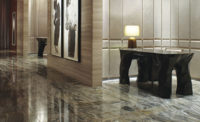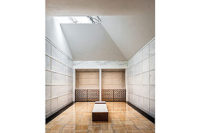The Pinnacle Awards competition is open to natural stone professionals from around the world and are presented to projects whose beauty, creativity, ingenuity and craftsmanship exemplify professional mastery in the use of natural stone in commercial and residential applications. Project teams must include at least one Natural Stone Institute member and the submitted projects must comply with association standards as defined in the Dimension Stone Design Manual and technical modules. The 2018 Pinnacle Awards were presented earlier this year at The International Surface Event (TISE) in Las Vegas, NV.
GRANDE PINNACLE Award of Excellence
Aura | Liberty Lake, WA
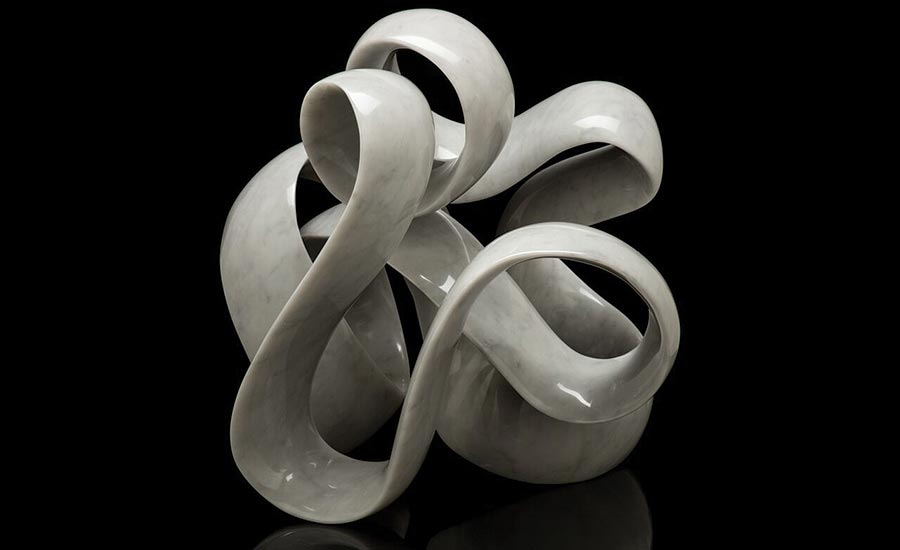
Fabricator: Mario and Son, Inc.- Liberty Lake, WA (Natural Stone Institute Member Company)
Designer/ Sculptor: Joey Marcella- Liberty Lake, WA
Stone Suppliers: Bonotti Stone Trading International- Massimo Galleni Sculptore
Stone: Bianco Carrara C marble
Project Description: Carrara marble conjures thoughts of elegance, timelessness and refined taste, begging to be caressed and admired. Aura is as much about the marble as it is the spaces in between, conveying a light and airy feel, a startling juxtaposition to what one typically associates with heavy rugged stone.
The stone needed to be solid and dense enough to retain structural integrity when carved thinly with a lot of negative space. An 8-cubic-foot, half-ton block of statuary grade Bianco Carrara C marble was sourced in Pietrasanta, Italy and meticulously tested for any fissures. It would ultimately be reduced down to a mere 80 pounds, while retaining most of the original volume. Inside this framework is a continuous band, weaving in and out of itself, playing with light and shadow among suggestively feminine curves. The luminous nature of the stone allows light to penetrate the thin edges — producing a glowing halo effect, hence the title of the sculpture, Aura.
The 16-month execution of this work began as a small metal ribbon bent into a pleasing asymmetrical shape, capable of being displayed and viewed from multiple perspectives, with no defined “base.” Utilizing modern technology, this metal prototype was digitally scanned and refined within a 3D computer modeling program, and eventually 3D printed to scale in plastic. An Old World measuring device, the Macchina di Punta, was employed to mark specific points on the model that were transferred to the block, allowing the shape to be copied into the marble by hand, in the tradition of the old masters. Hammer and chisel methods eventually had to yield to hand-held, rotary abrasives, as the piece became thinner and more fragile. The entire piece was meticulously hand sanded, to achieve the deepest and most spectacular polished finish.
Award of Excellence: Commercial Interior
2000 L Street Alexander Court | Washington, DC
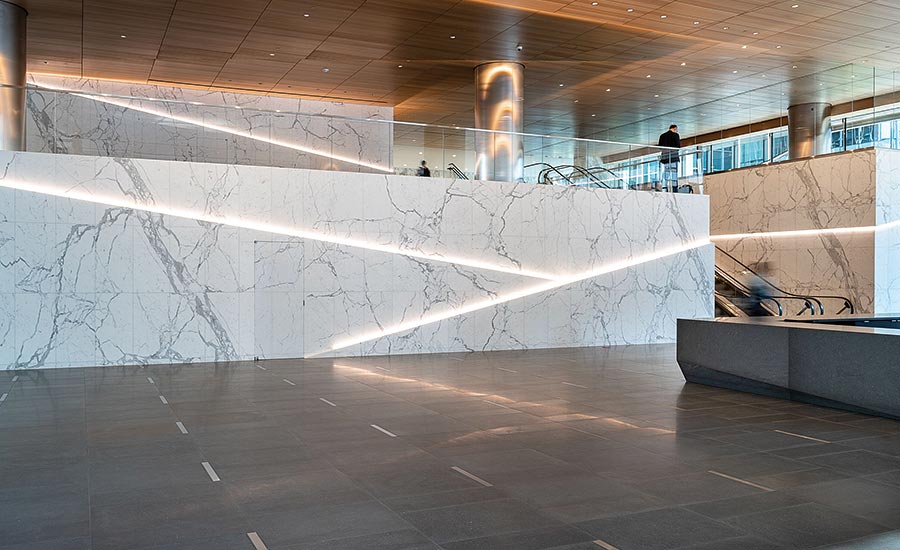
Stone Consultant/Supplier/Fabricator/Installer: Rugo Stone, LLC - Lorton, VA
Architect: Pelli Clarke Pelli Architects- FOX Architects
Stone Fabricator : Euromarble S.r.l. (Natural Stone Institute Member Company), A. Lacroix et Fils Granit Lte’e (Natural Stone Institute Member Company)
Stones: Statuario Venato Extra marble, Arabescato Vagli marble, Basaltite Extra Dura basalt, Jet Mist granite
Project Description: Alexander Court was a very ambitious project designed to merge two existing office buildings into one larger office building. This project is now the largest office building lobby in Washington, DC.
Designed by renowned Pelli Clarke Pelli in collaboration with Washington, DC-based FOX Architects, the building utilizes 90,000 square feet of stone. Alexander Court offers frontage along four major thoroughfares, including an entrance on K Street, and an expansive lobby fronting L and 20th Street featuring an iconic 12-story atrium.
The design is extremely unique because of the creative design of the project architect, Ms. Magdalena Kowalska, and her desire to use only the finest Statuario Venato Extra marble for the vast amounts of lobby wall stone. The walls are a reproduction of the vein pattern of the quarry wall face, this continuous vein pattern match was created by the fabricator Euromarble S.r.l using their innovative virtual dry-set software. This is a very detailed process which yielded unprecedented results for the marble finished appearance. The design also includes angular LED lighting which is hidden in the out of plan wall design to cast light both upward and downwards to create a very elegant modern approach to public space lighting, as well as to feature the elegant wall marble. This continuous vein matching was used on over 15,000 square feet of wall surface with walls as long as 180 feet.
The public lobby flooring is more minimalist and relies on a very hard and durable basalt called Basaltite quarried in the Italian region of Lazio. This elegant dark gray/black flooring accented with inlaid stainless steel accent pavers provides a truly subtle and strong foundation for the amazing wall marble features. The lobby desks are all clad in stone as well, and exhibit a complex geometry design.
The entire project relies on the Statuario and the Basaltite for all the paving and wall surfaces at the main lobby, the sky lobby, the fitness center, the 16 elevator cabs and the penthouse lobby. The core bathrooms are also paved in Basaltite, with Arabescato Vagli vanity tops. The building entries which include stone paving, steps and solid planter walls are clad in Jet Mist granite produced by Lacroix.
Alexander Court is receiving very high praise from the architectural, commercial development and commercial leasing communities for its design, craftsmanship and tenant amenities.
Award of Excellence: Commercial Interior
Apple Steve Jobs Theater | Cupertino, CA
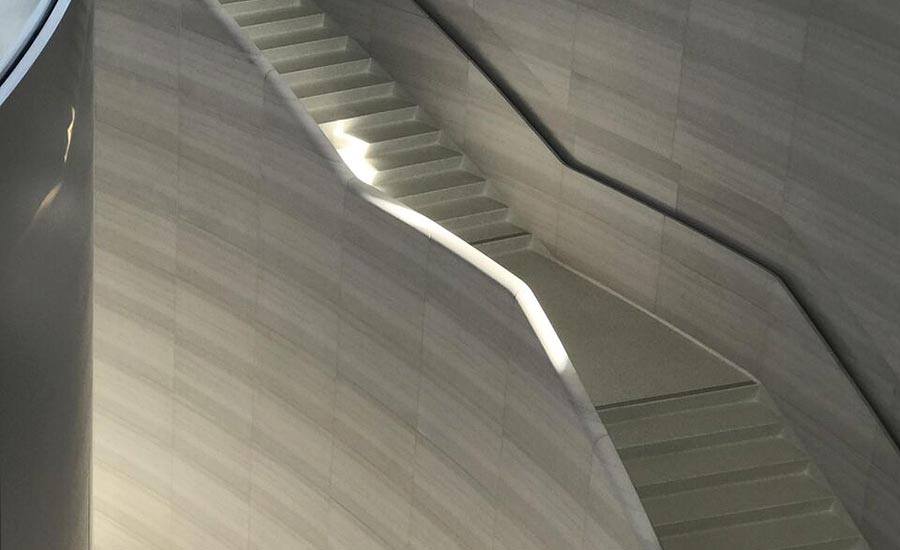
Stone Installer/Fabricator: Columbia Stone Inc.- Tualatin, OR
Architect: Foster + Partners
Stone Supplier/Fabricator : Campolonghi Italia SpA (Natural Stone Institute Member Company)
Stone Drawings/3D Modeling: PICCO Engineering (Natural Stone Institute Member Company)
Stone Carver: Andrusko Group (Natural Stone Institute Member Company)
Stones: Serpegiante limestone
Project Description: Columbia Stone’s contribution to the Apple Steve Jobs Theater is a good example of how to achieve success when working with a difficult stone. Approximately 12,000 square feet of heavily veined Serpegiante limestone from Italy was applied as two major elements: 2-inch-thick radial wall cladding and 10-inch-thick, two-piece carved handrails. The design requirements of this project specified precise radial fabrication of +/- 1 millimeter and 1/3-inch custom sanded caulk joints with -0 inch to + 1/32-inch tolerance.
Material was selected from only half of the limestone quarry bench level four to get the specific color and veining for blending. The first block was cut to the thickness required for radial wall cladding or handrail pieces. Rough slabs were cut and dry laid for initial review of color and characteristics. Once an area was approved, individual pieces were sent to five axis CNC cutting machines for rough carving.
The pieces were dry laid again to assure the quality established for color and blend was still being met. Once all pieces in a group were fully approved, they were sent to the Andrusko Group of artisan carvers for detailing then moved to an offsite sandblaster for finishing. All finished pieces were returned to Campolonghi for final detailing, one more dry lay, final cut to size and touch up.
Final approval by Apple was required before the stone could be loaded for shipping. During the inspection process, each piece was given a unique mark. Including details for positioning to assure that each piece was located correctly on the wall.
The support of the stone involved a custom designed series of tube steel and Unistrut to allow for a very tight tolerance installation. Custom color sanded caulking was selected due to the high seismic design requirements in California.
The result is a beautiful use of a difficult stone, which will be showcased for years to come inside a very iconic modern design structure.
Award of Excellence: Commercial Interior
Bent and Light Singapore Showroom | Singapore
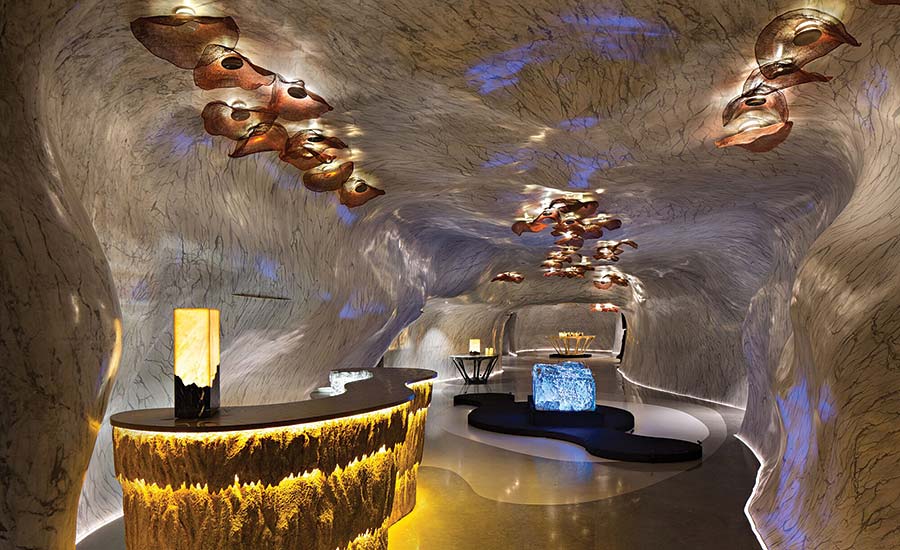
Owner: MM Galleri by Sharikat Stone- Singapore
Architect/Interior Designer: BK Interior Design and Architectural Planning
Stone Installer: MM Galleri
Stone Supplier: De Angelis Giovanni, Srl
Stone: Statuario GDA/Statuarietto marble
Project Description: Inspired by the underwater world in the story of Finding Nemo and born from a desire to break the perception that marble is rigid and heavy, MM Galleri acted on these ideas and had the “Bent and Light” project created as their stone showroom. This new bent marble technology was not only applied to the showroom’s floors, walls and ceilings, it also forms the creation of furniture pieces, such as a bar counter, spiral-shaped table, benches and more that maximizes marble’s flexibility and versatility.
Bent and Light utilized a proprietary process for reinforcing thin slices of marble with fiberglass to aid flexibility to recreate the underwater experiences depicted in the movie. Bent marble imitates the shapes of those environments, including a garden with corals, jellyfish and other underwater life. Decorative lighting is also a critical part of the design.
Challenged with how to apply the thin marble pieces so that the patterns achieved a continuous veining appearance, the team covered the seams with a special treatment to make the joining pieces appear more fluid. The innovator’s inspiration became reality in his desire to maximize the use of marble but also reduce stone waste. This method requires only 5% of natural marble material compared to a normal application since the resource is utilized more efficiently and minimal waste is produced.
Fabricated in Indonesia, the process required the incorporation of a model built with production sequence numbers. Installation of the 530-meter showroom in its fourth floor Singapore location carefully followed the model sequence numbers and was completed without any drilling into the material.
Award of Excellence: Renovation/ Restoration
Eggemeyer’s General Store | San Angelo, TX
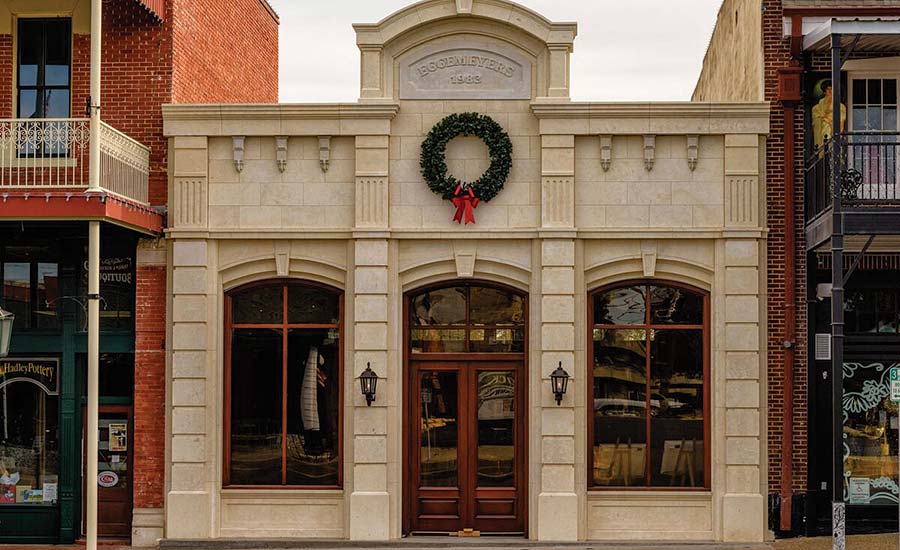
Stone Supplier: TexaStone Quarries- Garden City, TX
Client/Consultant: Eric Eggemeyer
Designer: Henry Schmidt Architect
Stone Installer: A J Langford Masonry
Stone: Cedar Hill Cream limestone
Project Description: Eggemeyer’s General Store, along with the surrounding buildings in the historic district of San Angelo, TX, was originally designed by architect Oscar Ruffini (1858-1957). Providing continuity within the district was a main factor for the owner’s interest in choosing limestone from a nearby quarry for renovating the storefront. Of all the materials available to architects for the construction of courthouses, schools, residences and commercial buildings throughout Texas, limestone has been the obvious choice for the most lasting and stately impressions. Many elements of Ruffini’s original designs were incorporated into the final design of this project to capture the architectural antecedents that helped define the culture and design within the area.
Another factor for choosing limestone was to serve as a reminder of the importance of staying true to heritage, and to encourage more use of locally sourced material. The entire facade was clad with rich cream-colored Cedar Hill Cream limestone from TexaStone Quarries. Every element was hand crafted — from the base stones to the arched cornice which contained the largest pieces weighing 3,000 pounds each. These allowed the design to appear grand in stature, but not overpower the constraints of the facade. Other elements were fabricated in sections. Large panels above the doors and windows completed the openings and the limestone transitioned to a band where the original masonry existed. Limestone panel veneer completes the facade between the corbels and up to the center cornice arch.
The project presented its own unique challenges with designing around an existing structure. The success was based on the skilled masons and their craftsmanship and the professional relationships that were developed over time. The completed design provides continuity within the historic district and will easily tie in with future projects.
Award of Excellence: Commercial Exterior
The James Museum of Western and Wildlife Art | St. Petersburg, FL
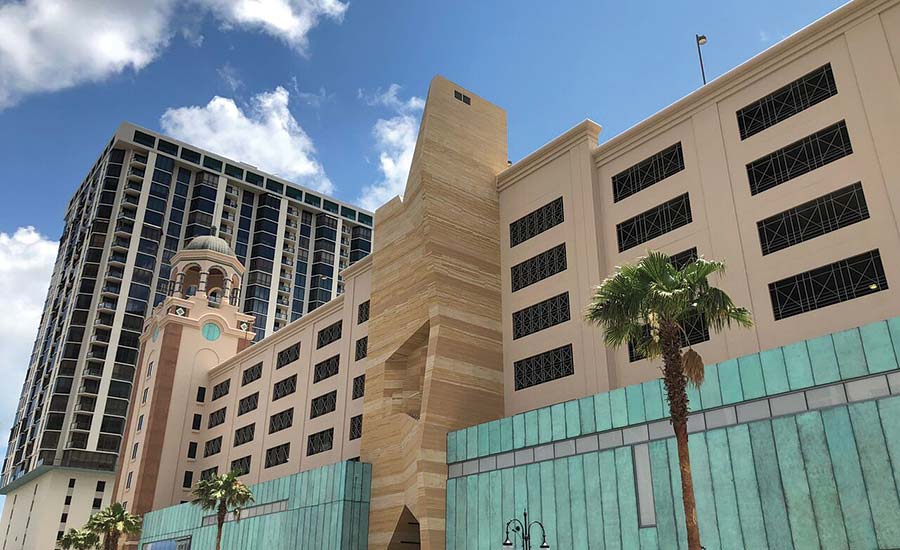
Stone Quarrier/Fabricator: TAB India- Hosur Taluk, India
Architect: St. Petersburg Group
Stone Supplier: ASI Stone Imports (Natural Stone Institute Member Company)
Stone Installer: Intrepid Enterprise
Stone: Teakwood sandstone
Project Description: The James Museum of Western and Wildlife Art is a relatively small, but complex and beautiful recent construction in St. Petersburg, FL. Built to conjure the magnificence and particular beauty of the southwestern U.S., the clients and their design team set off on a mission to find a material with the correct striations that evoke the canyons and ravines of Nevada, Arizona and Utah. Teakwood sandstone from near Jaipur, India was ultimately selected to complete the exterior “Mesa” facade and the interior “Arroyo” gallery and event space of the museum.
Procurement and fabrication of the museum were both large undertakings due to the very particular veining and style requirements of the building design and the complexity of the cutting required. A team of experts from all aspects of the job flew to India to agree on a range of color and texture suitable for the different parts of the job. Once set, the next challenge was the complex cutting of angled pieces in addition to the vein matching and shade matching. This required every piece from every row to be cut from the same blocks, so there was a massive amount of pre-planning of each block and then pre-laying the entire project prior to shipment. Ensuring nothing was broken in the process was a challenge, not to mention getting a picture of each section approved prior to shipment. In the end, 31,500 square feet comprised of 4,406 unique panel pieces with thicknesses ranging from 2cm to 5cm were shipped to the project site. Installation was no less complex, taking 10 months to complete.
Award of Excellence: Commercial Exterior
LDS Philadelphia Pennsylvania Temple | Philadelphia, PA
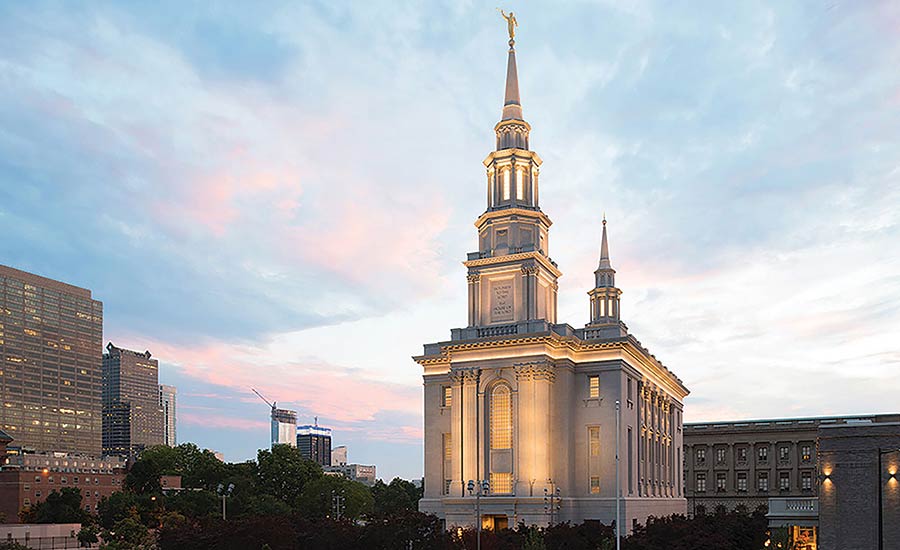
Stone Consultant/Installer: Dan Lepore & Sons Company- Conshohocken, PA
Architect: Perkins + Will- FFKR Architects
Stone Supplier: A. Lacroix et Fils Granit Lte’s (Natural Stone Institute Member Company)
Stone: Deer Isle granite
Project Description: A gathering place for Mormon faithful throughout the region, the LDS Philadelphia Pennsylvania Temple is in the heart of this historic city. This temple serves as a spiritual gathering place for members of the church throughout Pennsylvania and New Jersey and is the inspired result of meticulous, in-depth study of period architecture and the historic Philadelphia urban fabric dating back to the 19th century.
Clad in cut stone, the temple is highly detailed in the Neo classical revival style of American Georgian architecture. Bold lines are capped by two soaring spires. The massing of the building responds to the adjacent Renaissance Revival icons of the Philadelphia Free Library and the Family Courts Building.
The British-influenced Late-Georgian Style was selected as a guide for the temple’s architectural interiors. The American interpretation of this style was meant to reflect ancient notions of democracy, citizenship and freedom of religion. Simple materials, unembellished, but with the enduring forms of ancient temples came to symbolize all that was new and great about our fledgling nation.
Classical architectural orders are used to emphasize the patron’s journey through the temple. Beginning at the entry, the detail of the trim and columns is in the stately and simple Doric order. Spaces become more formalized as patrons travel through the second and third floors as the trim and columns become slightly more embellished in the Ionic order. Finally, light colors and the rich ornament of the Corinthian order are reserved for the most reverent spaces – the Celestial Room and fourth floor Sealing Rooms.
The architectural drawings and details for the exterior envelope were done in considerable detail which shortened the time and effort needed to prepare the shop drawings and cutting tickets. All the details of traditional architecture after the Corinthian order are present in full relief. The large fluted pilasters are full thickness cubic stone as are the carved acanthus leaf capitals. The ornamental window surrounds, the rusticated base and the two stepped towers are all in cubic stone. A deliberate effort was made to have this building be true to the historic classical details. However, there was an effort made to maximize the use of thinner (3cm) veneer stone to save the expense of the cubic stone. The design team worked carefully with the structural engineers to design the building to be able to carry the heavy loads of the thick stone veneer – some of the pieces weigh over 5000 lbs. The fabrication and carving completed by the stone masons were consistent with the designer’s vision.
Award of Excellence: Renovation/Restoration
Neptune Pool | San Simeon, CA
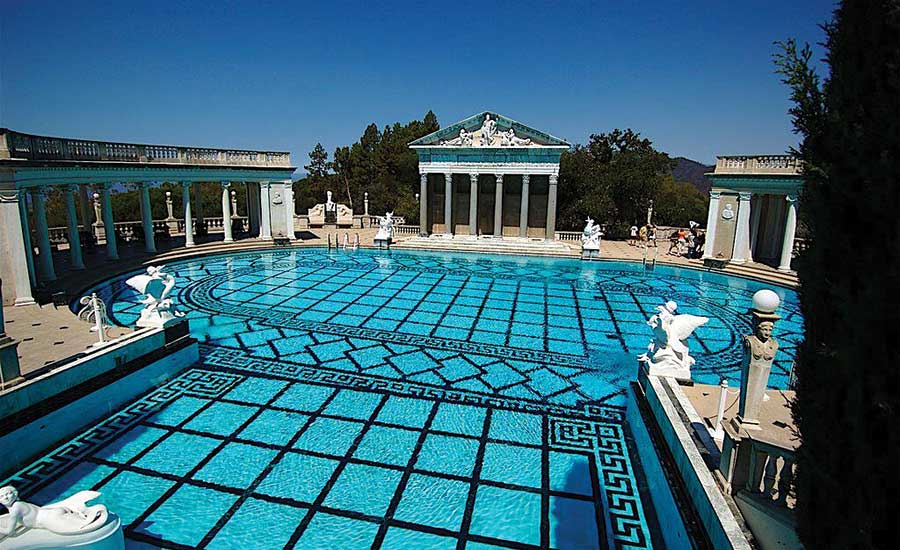
Stone Contractor: Carnevale & Lohr, Inc.- Bell Gardens, CA
Architect: Page & Turnbull
Stone Supplier: California Department of Parks and Recreation, Vermont Verde Antique (Natural Stone Institute Member Company), Vermont Quarries Corporation (Natural Stone Institute Member Company)
Stone Supplier & Consultant: Sutherland Falls Stoneworks Inc., Proctor, VT
Stone Fabricator & Carver: Proctor Marble Company, Proctor, VT
Supplier (Setting Materials): Custom Building Products (Natural Stone Institute Member Company)
Material Consultant: Trade International (Natural Stone Institute Member Company)
Installation Consultant: Ceramic Tile & Stone Consultants (Natural Stone Institute Member Company)
Stone: Verde Antique serpentine | Olympian White marble
Tile Contractors: Carnevale & Lohr, Inc., Bell Gardens, CA; Charles McCandless Tile, Inc., Santa Ana, CA
Conservator: Risser Conservation Services
Project Description:
Originally designed by Architect Julia Morgan, this classically styled pool whose basin, gutters and alcove are completely lined in Vermont marbles and features overlapping diamond and Greek Key patterns, as well as marble ladders with marble handrails, was begun in 1924 on William Randolph Hearst’s lavish estate in San Simeon, CA, and named the “Neptune Pool.” After being redesigned and expanded three times during its construction, it was finally deemed complete by Mr. Hearst in 1936. His 345,000-gallon pool is 104 feet long and 58 feet wide (95 feet wide at the alcove) with over 3,000 square feet of Verde Antique marble and 7,000 square feet of Olympian White marble.
Due to leakage from a cracked pool shell and an historic drought in California, the pool was drained in 2014. After a considerable amount of study and planning, it was determined that all the marble veneer in and around the pool would need to be removed and replaced so that the pool shell and aging plumbing could be repaired. The pool, being a national historic landmark would need to be replaced with the same type of marbles as the original, reproducing the original marble’s patterns and placement. Color selection and blending of the marble tiles would also need to match the original installation. Before demolition of the original marble cladding, 3D laser scans of the pool were performed and used to document the location and shape of every piece of over 19,000 marble tiles. This information was used to create shop drawings and cutting files for the fabrication and installation of the marble tile. Due to high visibility and prominence, the stone pool ladder carvings were done with extreme care and old-school craftsmanship by the fabricator, Proctor Marble Company of Proctor, VT. Many of the curved tile floor elements were precut on a CNC water jet and individually numbered to ensure proper placement. During the re-installation, a combination of templates and state-of-the-art survey equipment were used to replicate the original placement of every tile down to a tolerance of 1/8-inch in variance from original placement, with joints averaging 1/32 of an inch in width. Extensive hand fitting of tiles onsite was required to meet these tolerances. As each area was completed, another survey was performed to ensure compliance to the project’s requirements. The tiles were also painstakingly sorted to re-create the original blend of colors that was apparent in the original pool. Hundreds of hours were spent reviewing photos, videos and survey information from the original installation to make certain that the new installation would capture even the smallest of details.
After five months of work, experienced masons had restored this iconic marble pool back to its original luster. Future generations will be able to enjoy Roman and Greek inspired stonework exactly as it was when it debuted back in 1936.
Award of Excellence:Public Landscapes/Parks/Memorials
The Park at MGM Resort | Las Vegas, NV
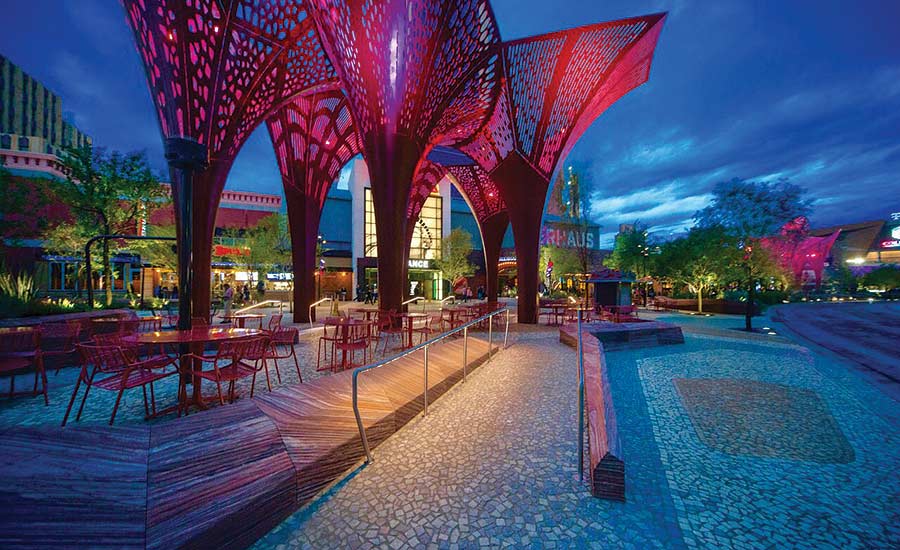
Stone Supplier/Fabricator: Las Vegas Rock-Jean, NV
Client: MGM Resorts International
Architect: !Melk Landscape Architecture & Urban Design
Stone Installer: Shaw-Lundquist Associates Inc.
Stone: Metaquartzite
Project Description: The Park, MGM Resort’s dynamic outdoor dining and entertainment district, is a refuge from the hustle and bustle of the Las Vegas Strip. It was envisioned as a central gathering place patterned after the great parks, plazas and squares that the world’s finest cities enjoy. The area is a lush promenade featuring avant-garde stone planters, native plantings, monumental shade structures and cascading water walls.
The goal was to create a space where stunning desert landscapes and cutting-edge design work in harmony. The approach was to eschew the Vegas tradition of creating illusions of something else, and instead create a place that is directly and authentically inspired by the city’s context, history and landscape.
As one of the prolific building elements of The Park, metaquartzite measures up to The Park’s intricate sustainability requirements that stretch far beyond the standard. The metaquartzite’s vivid strata variations introduce colors that are characteristic of the southwestern landscape to Las Vegas Boulevard, reminiscent of some of Nevada’s most iconic natural landmarks. The pieces produced for The Park are giant crystal-like planters that contain the native flora that bring the desert to bloom at the heart of The Strip. Created by nature and crafted by man, metaquartzite mirrors the dual worlds that intersect within The Park.
To achieve the multi-dimensional surfaces of the crystals, the most advanced stone-cutting technology was required. Using seven-axis wire saws acquired specifically for the project, 3D computer programming was utilized to carefully slice the massive pieces of rock from multiple directions and angles. These technologies were so new that software systems to program the multiple cuts and angles had to be developed. A total of 596 crystals were produced into 17 exclusive areas of The Park including: ornate planters, directional paths and water features. Of all 596 crystals, no two are identical. Eighty-six of the crystals presented distinct challenges such as, unique complicated contours, double-sided complex geometries or giant assemblages that had to fit together flawlessly. To assure fit and accuracy, every piece was pre-assembled.
Overall, there is a total of 2,225 linear feet of crystals that were 3D cut, pre-assembled and windswept. The results are geometric pieces with six precision cut sides that fit together sequentially, creating stunning exteriors for The Park. Envisioned as an experiential eco-oasis mirroring the Mojave Desert’s striking natural beauty, The Park is unlike anything ever constructed on the manmade marvel that is The Las Vegas Strip. In many ways, The Park represents a return to the land for a city whose development history has traditionally stood in stark contrast to its native ecology.
Award of Excellence: Renovation/Restoration
Provo City Center Temple | Provo, UT
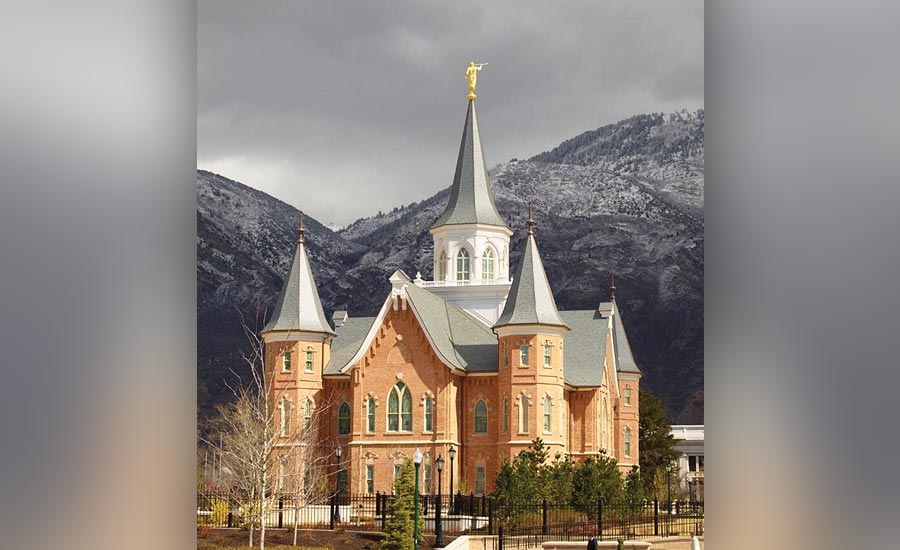
Stone Fabricator: Delta Stone Products- Heber City, UT
General Contractor: Jacobsen Construction
Stone Supplier: Mountain Valley Stone (Natural Stone Institute Member Company)
Stone Installers: RJ Masonry (Natural Stone Institute Member Company), Child Enterprises
Stones: Mountain Valley quartzitic sandstone
Project Description: The Provo Tabernacle was originally built in 1882 and has been a center for the community’s activities for the last 100 years. In the early morning of December 17, 2010 a misplaced electrical light started a fire in the attic of the historic tabernacle. The fire completely destroyed the building except for the exterior masonry walls. At the October 2011 LDS General Conference, after working through a preliminary design, the Church of Jesus Christ of Latter Day Saints Church President, President Monson, announced that the tabernacle would transition to the Provo City Center Temple. The design then began in earnest and required 14 months to complete.
In order to transform the tabernacle to a temple, a majority of the temple support spaces had to be located in the basement and under the north plaza. This would require excavating down 40 feet below the building with the help of 411 micropiles.
To create the design vocabulary for the building, historic details were used from the original Provo Tabernacle. Other inspiration came from Victorian Design movements: Eastlake and High Gothic Revival. Materials and finishes historically had high contrast and vivid colors, which were toned and controlled for a temple experience. Eastlake movement predominantly rejected the traditional Victorian color pallet and used three color selections: olive green, rust red and ochre yellow, with touches of green/blue.
Most of the exterior of the shell was able to be reused instead of tearing it down. In an effort to not only match the historic look of the structure but also to match the existing stonework on the building, Mountain Valley quartzitic sandstone was selected to replace damaged stone accent elements and create new accent and landscape elements. Because of the dense and durable nature of the stone, Mountain Valley stone was able to deliver the match to the original stone, some of which was able to be salvaged and reused from the original structure, as well as a promise to perform well for the decades or centuries to come. This stone was also used extensively throughout the new underground parking structure.
Construction for the project took approximately four years and eight months. The building was dedicated on March 20, 2016. Because of the herculean efforts of the design, construction and fabrication teams, the integrity of this beloved historic landmark has been preserved and future generations will be able to use and appreciate this great structure.
Award of Excellence: Commercial Interior
Sacred Heart Cathedral | Knoxville, TN
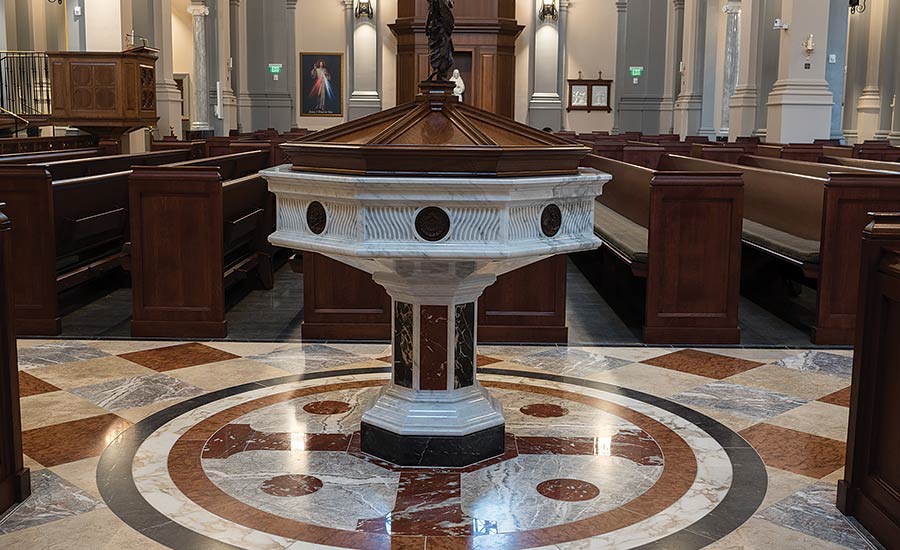
Stone Consultant/ Fabricator/Installer: Rugo Stone, LLC- Lorton, VA
Architect: McCrery Architects, LLC
Stone Fabricators: Pedrini Mario & Co. SNC Scultori, A.Grebelsky and Sons
Stones (partial list): Giallo Siena Brocatello marble, Bianco Carrara C Campanili marble, Grigio Carnico marble, Statuario Michelangelo marble, Campan Payole Gris marble, Rosso Francia Languedoc marble, Fior di Pesco marble, Nero Portoro marble
Project Description: For Sacred Heart Cathedral, the design architects relied heavily on the architectural stone detailing of the Old World to deliver a level of design, stone details and ornamentation rarely found in the New World.
A field of diagonal and radiating patterns of marble paving greets visitors upon entering the narthex and repeats along the perimeter aisles and transepts, while two solid columns of fragile Giallo Siena Brocatello marble stand at each side of the entry. Within the nave and aisles are 14 specially engineered solid columns of Bianco Carrara C Campanili marble, strategically set upon Grigio Carnico solid octagonal and veneer marble bases.
The paving in the raised sanctuary is a mosaic carpet of stone comprised of 12 types of marble and over 2,000 pavers and treads. In the center is the Altar of Sacrifice made of polished Statuario Michelangelo marble with waterjet cut face panels of Campan Payole Gris, Giallo Siena Brocatello and Rosso Francia Languedoc marbles that surround three stone and glass mosaics.
A raised Altar of Reservation is made from polished Statuario Michelangelo marble with Grigio Carnico treads and Fior di Pesco risers along with various other marbles used as accent stones within the wall panels and paving. Set upon the Altar of Reservation is the tabernacle surround of Rosso Francia Languedoc and Giallo Siena Brocatello solid columns supporting the Ciborium.
The baptismal font basin is solid Bianco Carrara C Campanili marble with an intricately carved side wall supported by a solid shaft of marble with inlaid panels of Rosso Francia Languedoc and Nero Portoro set upon a Grigio Carnico base.
The center panel of the raised cathedral is made of solid Fior di Pesco marble with inlaid diamond book matched panels. The Bishop’s coat of arms is another exquisitely detailed panel of mosaic patterns and inlaid stones.
Award of Excellence: Residential Single Family
Urban Villa | New Orleans, LA
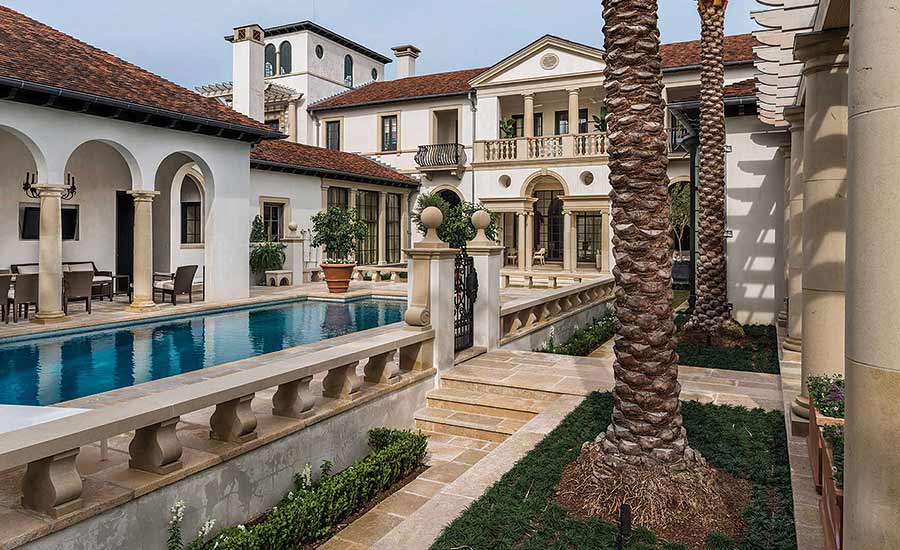
Stone Fabricator: Continental Cut Stone- Florence, TX
Architect: Ken Tate Architect
Stone Supplier: Continental Quarries (Natural Stone Institute Member Company)
Stone Carver: Texas Carved Stone
Stone Installer: Williams Masonry
Stone: Lueders Buff limestone
Project Description: Located in the famed historical district of St. Charles, named as one of the great streets in America by the American Planning Association, unique needs were shared with the owner’s vision. Combining classical elements inspired by the architecture of Andrea Palladio with those recalling the romantic character of the Mediterranean Revival, this 12,800-square-foot house pays homage to and enhances the extraordinary streetscape.
Inspired by Palladio’s Basilica in Vicenza, the facade features a single-story portico with a cut-stone arcade and a balustrade terrace above. Offset by the overall simplicity of the facade, the portico’s effect is dramatic without overshadowing the surrounding architecture. Located on a corner, the house has a secondary facade with picturesque Mediterranean Revival features, including iron gates, a second-story pergola and a tower.
Accommodating the client’s art collection, interior plan combines smooth plaster walls and simple casings with adorned ceilings, including groin and barrel vaults, beams and paneling. Texas Buff Lueders was selected and fabricated for all of the cut stone material on both the inside and outside of the house. The fabrication challenges included engaged columns at the front portico. Many intricate details throughout the project required attention to detail in both drafting and fabrication.
After the stone was cut, all of the surfaces were meticulously hand distressed in a subtle manner that beautifully enhanced the inherent aspects of the stone. Every piece of limestone on the house was brushed by hand – each subtly different. The Lueders selected lends itself greatly to the carving aesthetic and techniques used for the project, and helped to achieve the timeless quality that the architect sought for the project. The hand-carved copy of a Palladian mantel that might have dropped straight down from Veneta and awakens the power to trigger memories of places and things that may have never been encountered.
Award of Excellence: Commercial Interior
Waldorf Astoria Hotel | Beverly Hills, CA
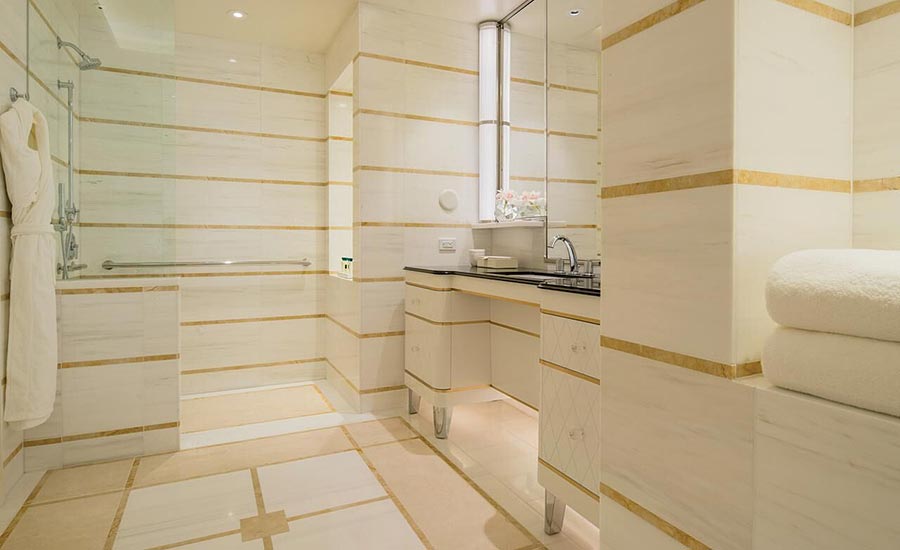
Stone Installer/Fabricator: SMG Stone Company, Inc.- Sun Valley, CA
Architect: Gensler
Designer: Pierre-Yves Rochon
Stones: Bianco Dolomiti marble, Crema Marfil marble, Amarillo Negras marble
Project Description: The legendary Waldorf Astoria Hotel made its debut to the city of Beverly Hills in the summer of 2017. The 12-story tower evokes classic Hollywood glamour and celebrates California style. SMG Stone was the stone installer and fabricator for the interior 170 rooms and 51 suites guest of the hotel. Inspired by the Art Deco and Streamline Modern styles of the 1930s and 40s, the design team resisted trends toward exotic materials and returned to classic tones selecting three natural stones: Bianco Dolomiti marble, Amarillo Negras marble and Crema Marfil marble.
12- x 24-inch pieces of Bianco Dolomiti were installed on the bathroom walls and floor. Each of the bathroom walls feature a 1 ½ -inch band of Amarillo Negras in a polished finish that was bonded with epoxy to the Bianco Dolomiti. This fabrication detail created a 180-degree continuum that wrapped the bathroom in a warm yellow hue. Every one of the wall bands was installed to line up with one another both horizontally and vertically with some walls containing up to seven bands that faded into the door surround. This included bands lining up directly with the soap niche and a horizontal line detail on the light fixtures.
The bathroom floors included a stone medallion consisting of all three marbles. The tub and skirt were composed of Crema Marfil while Bianco Dolomiti was used for the soap niches on the walls.
Desired patterns required joint tolerances of no more than 1/8 of an inch and thin set mortar bed depth of no more than 3/16-inch or else risk completely compromising the design.
Award of Excellence: Architectural Carving/Lettering/Sculpture
Winged Goddess of Victory | Portland, OR
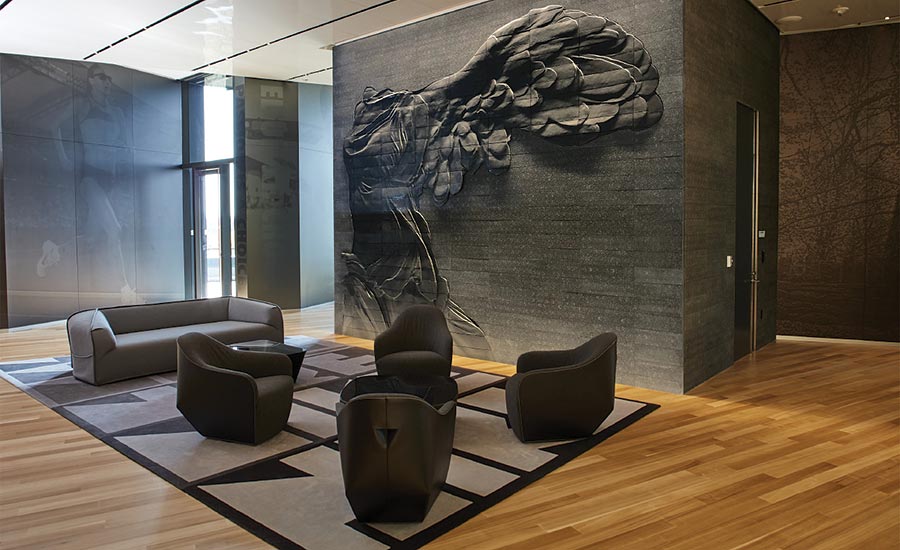
Sculptor: Andrusko Group- Portland, OR
Designer: Nike Design, ZGF
General Contractor: Hoffman Construction Co.
Stone Installer: Western Tile & Marble (Natural Stone Institute Member Company)
Stone Fabricators: Savema S.p.A. (Natural Stone Institute Member Company)- Stone NW
Stone Supplier: Stone NW
Stones: Local basalt- India Black granite
Project Description: Inspired by the iconic Nike of Samothrace, Winged Goddess of Victory is a massive bassorrilievo hard stone sculpture carved from basalt and granite. The artist was approached with a visual concept by the client’s general contracting firm in May of 2017 inquiring about whether it would be possible to execute such a sculpture. After months of discussion and testing, the artisan was able to develop the concept fully and proposed a viable means of executing the artwork to the client who subsequently commissioned the work by the Andrusko Group in Portland, OR.
The completion of this stone sculpture was performed in roughly just four-and-a-half months by a single artisan carver. It utilized six robotic machines to rough-in the individual modules, followed by finish work requiring an arsenal of hand-held tools. It is no exaggeration to assert that the client delivery date was so demanding that the artisan would have normally estimated a time frame three times longer than the schedule allowed. Great risks were taken both by the client and the artist to execute this artwork.
Larger and more complex than anything previously carved by the artist, the sculpture is magnificent in size at roughly 5 meters tall x 6 meters wide and is massively heavy. The scale necessitated minimizing the total mass while maximizing the relief detail that could be achieved. The detail is captured in a maximum 6cm of depth in a stone only 7cm thick. The artisan was concerned about ambient light interfering with the carving detail given the relative lack of depth, so LED lighting was deployed in the ceiling above the sculpture to help emphasize the carving detail.
The hope of any artist is to somehow imbue the breath of life into the inanimate; to effect in some profound way the beholder of the work. Andrusko is pleased and satisfied with the outcome, despite knowing that this artwork is not accessible to the public.

